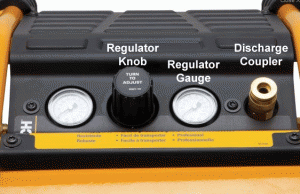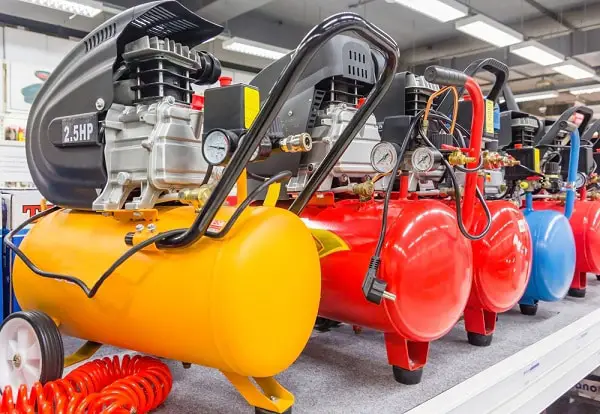What is the compressor air regulator, and what does it do?
The compressor air regulator is typically found on the outgoing air line.
That same air line runs from the tank, may run through some gauges or other accessories, but then typically runs into and through the air regulator and then on to the discharge coupling.
The discharge coupling is the device on the air line from the compressor into which you plug the connector on your air hose.
The compressor air regulator is sometimes not visible. Like the one shown in the following image, the air regulator knob is visible, the air regulator gauge is visible, but the actual air regulator – onto which the regulator knob connects – is hidden behind the air compressor covering.


Compressor Tank Pressure
When your air compressor runs, air pressure builds up in the compressor tank. When the tank pressure reaches the normal cut out pressure setting of your compressor pressure switch, the air compressor stops.
For purposes of example, let’s say that your air compressor pressure switch cuts out at 150 PSI pressure. That means that there is now a quantity of compressed air in your tank at 150 PSI pressure.
When you connect your air hose to the discharge coupler on the compressor, you now have compressed air in the air hose to your air tool that is at 150 PSI pressure.
While you can run many air tools at that 150 PSI, if you don’t need that much force – after all, force = pressure x area – then you are wasting energy by using higher air pressure than needed, and you are increasing the wear and tear on your air tool by driving it with way more air pressure than may be necessary, or even good for the air tool.
That’s where the air regulator comes in!
The air regulator is designed to allow you to dial down the air pressure that goes to your air hose and your air tool.
How much compressed air pressure do you need in your air tool? The general rule is to lower the air pressure to the lowest regulator setting at which the air tool will run properly.
This reduces air use, reduces energy cost and reduces wear and tear on the air tool.
The regulator is designed to lower the pressure setting that the downstream hose and tool receives, and maintain that lower air pressure regardless of how high the air pressure stored in the compressor tank is.
Adjusting air pressure with the compressor regulator
Most air compressor regulators have a knob for adjustment. Some have a T-handle, yet the typical DIY air compressor regulator has a knob.
Typically, turning the regulator knob clockwise increases the downstream air compressor setting. Turn the regulator knob counter-clockwise reduces the pressure the air hose and air tool will receive.
If you have higher pressure in the hose than the new setting you have dialed in with your regulator, you may hear a hissing sound as the downstream pressure vents back through the regulator to reduce the downstream air pressure to the new, lower setting.
Cannot turn the regulator knob?
Some air regulators have an integral locking mechanism. The lock is engaged by either pulling up on the regulator knob, or pushing it down.
If you cannot turn the regulator knob on the regulator, try gently pulling or pushing down on it to see if the knob moves, and in so doing, unlocks the mechanism to allow you to make an adjustment.
The compressor regulator cannot raise pressure
The compressor regulator cannot raise the air pressure above the tank pressure!
If your compressor tank air pressure drops to, say, 50 PSI, even though the air regulator is set to 70 PSI, all that will flow downstream past the regulator is air at 50 PSI.
That is why, if you have a higher demand air tool, and a fairly small CFM capacity compressor, you might have your regulator set for 70 PSI, but as you use more air than your air compressor can generate, the pressure to the air tool drops below the minimum operating pressure for that air tool, and it can no longer do the work for which it is intended.
Got a question about your air compressor regulator? Post it using the comment box below and we’ll see if we can help.


why the compressor is run but no pressure?
Thanks for including the photo. From what you have written and looking at the picture, I believe that only one of those two couplers is regulated by adjusting the pressure regulator, and the other is delivering full tank pressure to the coupler. That is, unless, your compressor has another tank gauge? Typically, a smaller compressor like this one will have two gauges. One will be for the regulator to display the regulator setting and the other will be for displaying the tank pressure so it can be determined that the pressure switch is operating satisfactorily and to show the remaining… Read more »
I have a compressor with 2 quick connects for 2 tools to be connected. Does the pressure regulator control both? The only reason I ask this is that one of them has the pressure gauge that goes up and down with the pressure regulator while the other one which seems to be connected to the second quick connect and always shows the pressure of the tank.
I have a 1.8hp 26 gallon cheap compressor with low cfm 4 @90psi; 6@40psi. Im looking to purchase another 1.8hp with same specs. I will have them on seperate 15-20 amp breakers btw… (question is continued here: https://air-compressor-help.com/combining-air-compressors-to-increase-flow/)
I am assuming that you have not replaced the regulator? If so, check to be sure that the arrow on the body of the regulator points towards the air line coupler on the compressor, and not towards the tank. If your compressor tank is empty, and the regulator is set for 80 PSI, for example, when your compressor starts and builds pressure, will the tank pressure get to the normal cut out setting? And if it does, assuming that the pressure switch is set to cut out at – say – 125 PSI, and the compressor stops, what happens to… Read more »
I have a portable air compressor that has started leaking air out of the pressure regulator until it equals the tank pressure. Example: The regulator will leak continually until the regulator guage equals the tank guage. It leaks continuous unless turned all the way up to equal 150 PSI. Any setting less than 150, it will leak down the tank pressure until it matches the regulator pressure. Do I have a bad regulator or pressure switch?